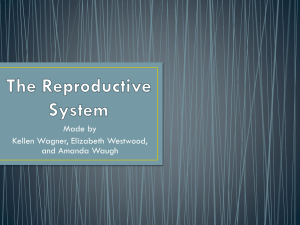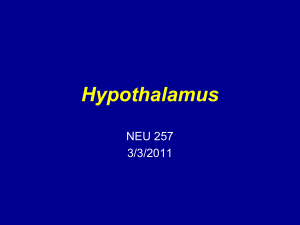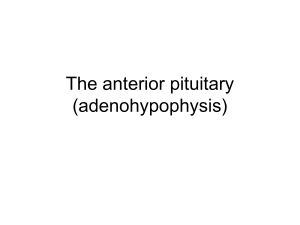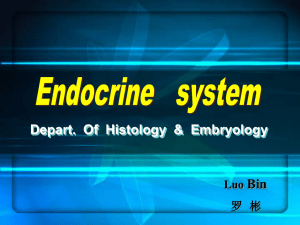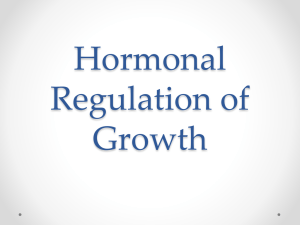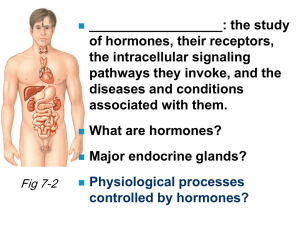categories of chemical regulators
advertisement
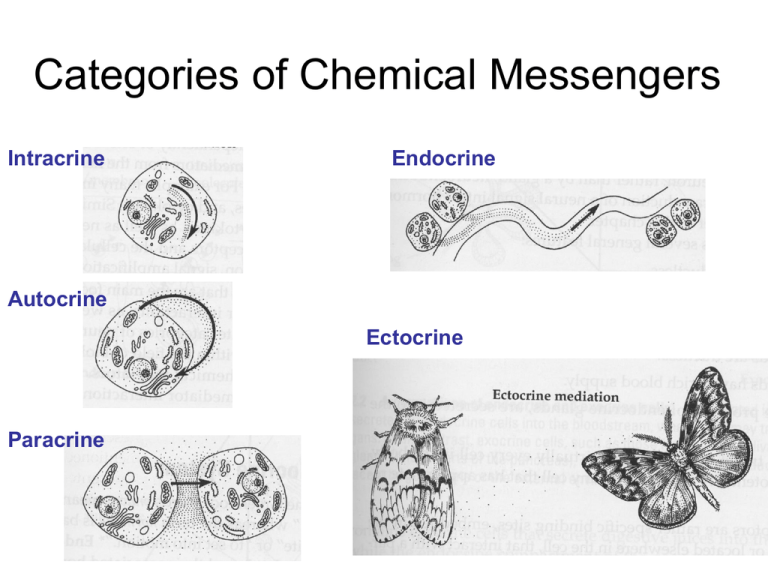
Categories of Chemical Messengers Intracrine Endocrine Autocrine Ectocrine Paracrine Endocrinology: study of hormones General Features of the endocrine system: Transport Gland Hormone Target Cell rich blood supply secreted into the blood ductless can reach virtually every cell in the body hormone receptors are very specific Endocrinology: study of hormones Transport Gland Hormones Functional classification Structural classification Target Cell Hormones: functional classification • Metabolism (i.e.: nutrient breakdown and absorbtion, and anabolic and catabolic metabolism) • Reproductive function • Growth and metamorphosis • Osmoregulation and excretion of water and salts • Synthesis and release of other hormones • Permissive actions • Stimulate muscle contraction (especially smooth muscle in the gut and genital tract) • Activational and/or Organizational effects on behavior Organizational vs. Activational Example: Sexual behavior Mounting behavior lordosis Hormones: functional classification • Metabolism (i.e.: nutrient breakdown and absorbtion, and anabolic and catabolic metabolism) • Reproductive function • Growth and metamorphosis • Osmoregulation and excretion of water and salts • Synthesis and release of other hormones • Permissive actions • Stimulate muscle contraction (especially smooth muscle in the gut and genital tract) • Activational and/or Organizational effects on behavior • Facultative Actions Ham Creek, Hudson Valley Hormones: structural classification • Helps us understand how hormones are: – Synthesized – Secreted – Transported – Have effects at the Target Cell • To start: what are the 4 major groups of organic compounds? • Biochem majors?..... Hormones: structural classification • Peptide Hormones – Made up of amino acid building blocks • 3 to <180 amino acids in length – Soluble in water? • Yes – Synthesis GnRH pGLU – His – Trp – Ser – Tyr – Gly – Leu – Arg – Pro – Gly – NH2 CELL Synthesis and secretion of a peptide hormone NUCLEUS DNA TRANSCRIPTION RNA PROCESSING RNA TRANSPORT releasing hormone mRNA mRNA TRANSLATION PROTEIN SYNTHESIS Peptide hormone secretion can be: 1) constitutive 2) regulated MEMBRANE PROTEIN PROCESSING PACKAGED IN A SECRETORY VESICLE SECRETION BY EXOCYTOSIS Hormones: structural classification • STEROIDS – All steroids are made from cholesterol – Water soluble? • NO • Almost all have binding proteins for transport in blood • They can pass across membranes – No storage – Receptors are intracellular – Synthesis CELL Synthesis and secretion of a Steroid hormone NUCLEUS Protein synthesis for: -Cell growth -cell division -Enzymes for mitochondria Mitochondria It also may occur in the endoplasmic reticulum enzymes stimulating hormone Cholesterol CH 3 C-CH 2-C5H11 steroid HO Steroid hormone secretion must be: constitutive It cannot be regulated Cholesterol store in cell MEMBRANE SECRETION Steroid Biosynthesis • All steroids start from cholesterol • Each arrow is one enzymatic step • Synthesis of a certain steroid will only occur if the appropriate enzymes are present Hormones: structural classification • Monoamines – Epinephrine, norepinephrine and dopamine • All derived from a single amino acid: tyrosine – Melatonin and serotonin • Derived from the amino acid tryptophan OH OH – Synthesis: H O C H H C H H N CH3 epinephrine • Enzymes present in cell alter the amino acid Hormones: structural classification • Thyroid hormones – Modified from amino acid tyrosine • Iodine is incorporated (think salt) – Two forms: thyroxine (T4 = four iodines) and tri-iodothyronine (T3 = three iodines) – Soluble in water? • No – Synthesis I Synthesis of thyroid hormones stimulating hormone I I vessicle Cell membrane I OH I I OH OH CH2 CH2 I I OH I I OH I I O lysozyme I enzymes I CH2 I CH2 CH2 OH thyroglobulin I I OH I O I Golgi apparatus I I CH2 O I I I CH2 cytoplasm Hormones: structural classification • EICOSANOIDS – Lipid hormones – All are derived from arachidonic acid (a fatty acid) • Prostaglandins-stimulate smooth muscle, induce inflammation and fever – Aspirin inhibits prostaglandin synthesis • Leukotrienes-contribute to inflammatory and allergic responses • Thromboxanes-facilitates clotting of blood platelets OH COOH PROSTAGLANDIN – Synthesis PGF2alpha OH OH • Arachidonic acid is synthesized from diacyl glycerol (DAG) Regulation of Hormone Levels How does the body recognize and regulate how much hormone is present in the blood? Negative Feedback simple HYPOTHALAMUS - CRH PITUITARY ACTH ADRENALS - = negative feedback Glucocorticoids (i.e. cortisol) Negative Feedback - HYPOTHALAMUS - GnRH PITUITARY - LH TESTIS Testosterone - = negative feedback Negative Feedback • A process where increasing hormone levels serve to shut down releasing and stimulating hormones ‘upstream’ • set-point level can be changed depending on season, parental care, environmental conditions, etc. Positive Feedback • A process where increasing hormone levels stimulate further secretion of releasing and stimulating hormones Endocrinology: study of hormones Transport Gland Hormone Target Cell Binding Proteins • 3 Important concepts • Binding globulin characteristics capacity and affinity two examples • Other binding proteins STRESSOR Central Nervous System hypothalamus Corticosteroid Binding Globulin CRH pituitary ACTH adrenals Glucocorticoids (cortisol, corticosterone) Target Tissue Transport • Binding proteins: – carry hormones in the blood • Important concepts – Bound vs. Free: In the blood there is hormone bound to binding globulin, and hormone that is free – Only free hormone can exit the blood stream • only free reaches tissue to bind receptors • only free can be broken down in the liver – ↑ binding protein = ↑ hormone bound, ? free hormone • ↑ binding protein = ↑ hormone bound, ↓ free hormone • So, binding proteins can regulate – Bioavailability – Clearance rates Characteristics of Binding Proteins • Affinity – how well hormone binds to binding globulin • tightly bound = high affinity • loosely bound = low affinity – Increase affinity…what happens to free hormone? – Human Example • Capacity – total number of binding globulins present – Decrease capacity…what happens to free hormone? – Bird Example White-crowned sparrows Total CORT (ng/ml) 60 total CORT 50 40 30 20 10 0 0-3 minutes Specific Binding (nM) 1 brood 600 500 30 minutes CBG capacity 400 300 200 100 0 pugetensis 2-3 broods oriantha gambelii Free CORT (ng/ml) 3.5 3 Free CORT 2.5 2 1.5 1 .5 1-2 broods 0 0-3 minutes 30 minutes Transport: Binding Proteins BINDING PROTEIN ABBREVIATION HORMONES BOUND Corticosteroid-binding globulin CBG Sex-steroid binding globulin SBG or SSBG Progesterone-binding globulin PBG glucocorticoids and progesterone Testosterone and estradiol progesterone Thyroxine-binding protein TBP Growth Hormone binding protein GH-BP Insulin-like growth factor binding IGF-BPs proteins Neurophysins I and II Corticotropin releasing releasing factor-binding protein CRF-BP Thyroxine and triiodothyronine Growth hormone Insulin-like growth factors I and II Vasopressin and oxytocin Corticotropin factor Review • Binding proteins: carry hormones in the blood • Important concepts -Bound vs. Free: In the blood there is hormone bound to binding globulin, and hormone that is free -Binding proteins regulate how much free H is available to tissues or alter clearance rate (how much will be broken down) • Affinity vs. capacity -CBG mutations in humans -CBG altering free CORT levels: bird example • So, binding proteins can regulate bioavailability and clearance rate of hormones Endocrinology: study of hormones Glands Transport Hormone Target Cell Endocrine Glands The human brain Human Brain: coronal section Lateral ventricles thalamus 3rd ventricle hypothalamus Human Brain: Sagittal Section Mammalian Pituitary Hypothalamus OC Infundibulum THE NOSE Posterior Pituitary Anterior Pituitary (neurohypophysis) (pars nervosa) (adenohypophysis) (pars distalis) Intermediate lobe (pars intermedia) Hypothalamus OC Infundibulum THE NOSE Posterior Pituitary (neurohypophysis) (pars nervosa) Oxytocin Vasopressin Hypothalamus OC Median Eminence Releasing and Inhibiting hormones are secreted from the hypothalamus Posterior Pituitary Anterior Pituitary (neurohypophysis) (pars nervosa) (adenohypophysis) (pars distalis) Intermediate lobe (pars intermedia) THE NOSE Portal System Hypothalamus Posterior Pituitary (pars nervosa) Median Eminence Intermediate lobe (pars intermedia) the nose Anterior Pituitary (pars distalis) Median eminence Hypothalamo-pituitary blood portal system Hypothalamoportal vessels Pars nervosa Pars distalis Hypothalamoportal vessels Pars distalis Median eminence Hypothalamus OC Median Eminence Releasing and Inhibiting hormones are secreted from the hypothalamus Posterior Pituitary Anterior Pituitary (neurohypophysis) (pars nervosa) (adenohypophysis) (pars distalis) Intermediate lobe (pars intermedia) MSH ACTH TSH PRL LH FSH GH endorphins THE NOSE Hypothalamus-pituitary control center hypothalamus Anterior pituitary Hypothalamus Posterior pituitary or Pars nervosa Median eminence Portal system Anterior pituitary Mammal hypothalamo-pituitary unit Hypothalamus Median eminence Pars intermedia Pars nervosa Pars distalis HypothalamoPortal vessels Endocrinology: study of hormones Transport Gland Hormone Target Cell Mechanism of Action Characteristics of Receptors • Two major components – Recognition site: specific for hormone – Effector: the portion of the receptor that changes upon hormone binding and initiates action in the cell Receptor as Enzyme G-protein coupled receptor Ligand-gated ion channel + G + + + ↑↓ second messengers Intracellular Receptor ↑↓ second messengers nucleus Receptor as Enzyme G-protein coupled receptor Ligand-gated ion channel G ↑↓ second messengers + + + Intracellular Receptor ↑↓ second messengers nucleus Receptor as Enzyme G-protein coupled receptor Ligand-gated ion channel G ↑↓ second messengers + + + Intracellular Receptor ↑↓ second messengers mRNA nucleus G-protein-coupled Receptors • G proteins activate enzymes – Adenylate cyclase which produces cAMP – Phospholipase C which produces IP3 and DAG • G proteins can be stimulatory (Gs) or inhibitory (Gi) • Once GTP returns to the inactive form (GDP), the -subunit is no longer active, and returns to the -subunit. Steroid Receptors cellular space Cytoplasm Nucleus DNA r 90 90 r r r r r 90 90 90 Protein Hormone-receptor binds to DNA synthesis RNA mRNA r space Intra-cellular space Extra- processing r Capillary Ribosomes hormone 90 r Heat shock protein 90 Hormone receptor • Steroid Receptors are transcription factors • They usually dimerize • Two major components: – Ligand binding domain (recognition site) – DNA binding domain (effector) • Contains Zinc fingers • Binds to DNA at Hormone Response Element Ligand binding domain R R Zinc fingers at the DNA binding domain DNA Hormone Response Element (HRE) Characteristics of Receptors • Two major components – Recognition site: specific for hormone – Effector: the portion of the receptor that changes upon hormone binding and initiates action in the cell • Common properties of all receptors – Specificity – Capacity – Affinity • H + R HR (law of mass action) E q u ilib r iu m S a tu r a tio n B in d in g C u r v e 100% receptors bound GR 80 [r ad io active C O R T b ou nd] 70 60 50 40 30 GR Kd = 4.0 nM 20 10 0 0 .0 2 .5 5 .0 GR 7 .5 1 0 .0 1 2 .5 1 5 .0 1 7 .5 [r ad io active C O R T in exp er im en t] 2 0 .0 (nM) 2 2 .5 2 5 .0 Equilibrium Saturation Binding Curve 80 MR 100% receptors bound [radioactive CORT bound] 70 60 50 40 MR Kd = 0.2 nM 30 20 10 0 0.0 MR 2.5 5.0 7.5 10.0 12.5 15.0 17.5 [radioactive CORT in experiment] 20.0 (nM) 22.5 25.0 E q u ilib r iu m S a tu r a tio n B in d in g C u r v e GR 80 MR [r ad io active C O R T b ou nd] 70 60 50 40 MR Kd = 0.2 nM 30 GR Kd = 4.0 nM 20 10 0 0 .0 MR 2 .5 5 .0 GR 7 .5 1 0 .0 1 2 .5 1 5 .0 1 7 .5 [r ad io active C O R T in exp er im en t] 2 0 .0 (nM) 2 2 .5 2 5 .0

